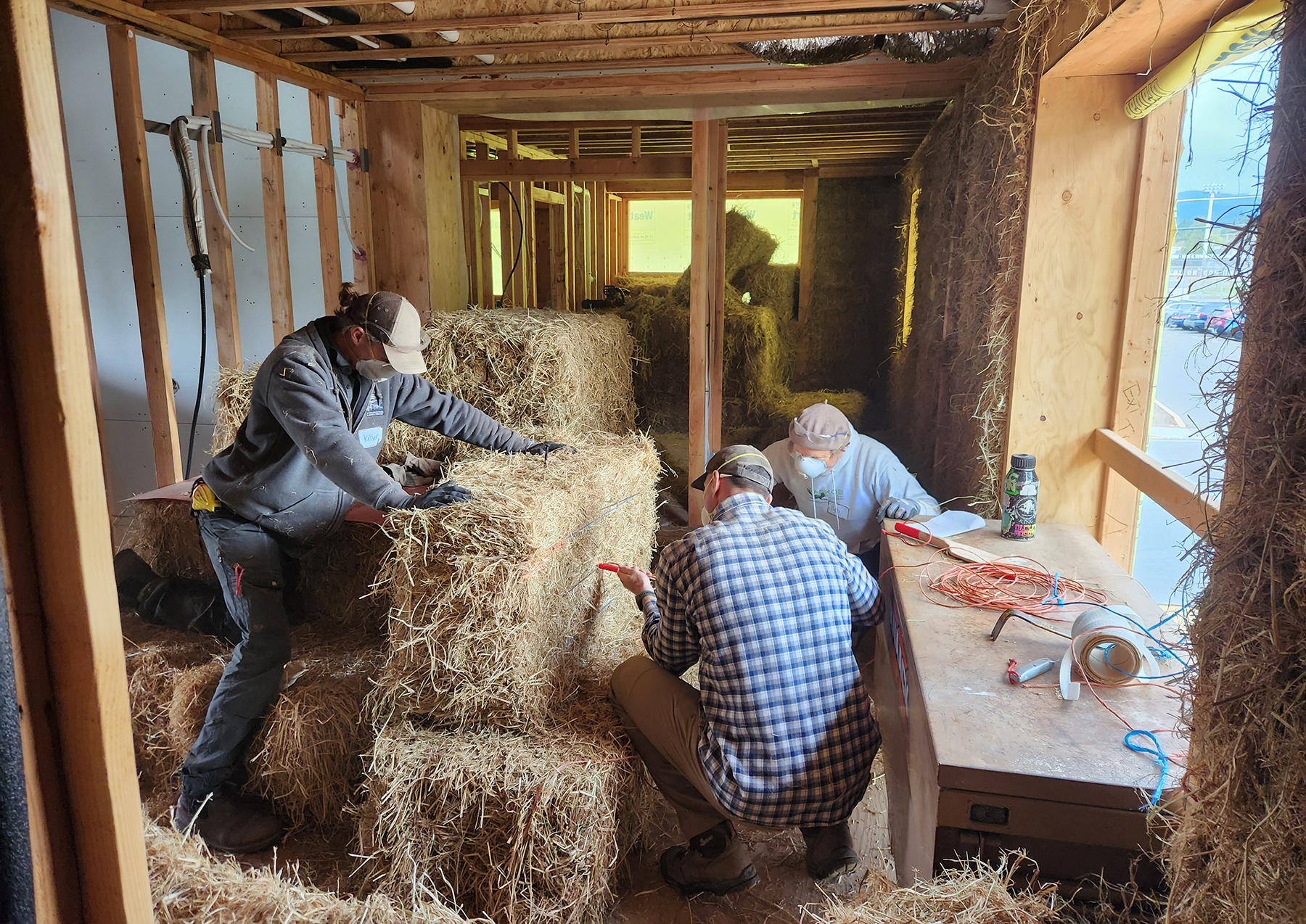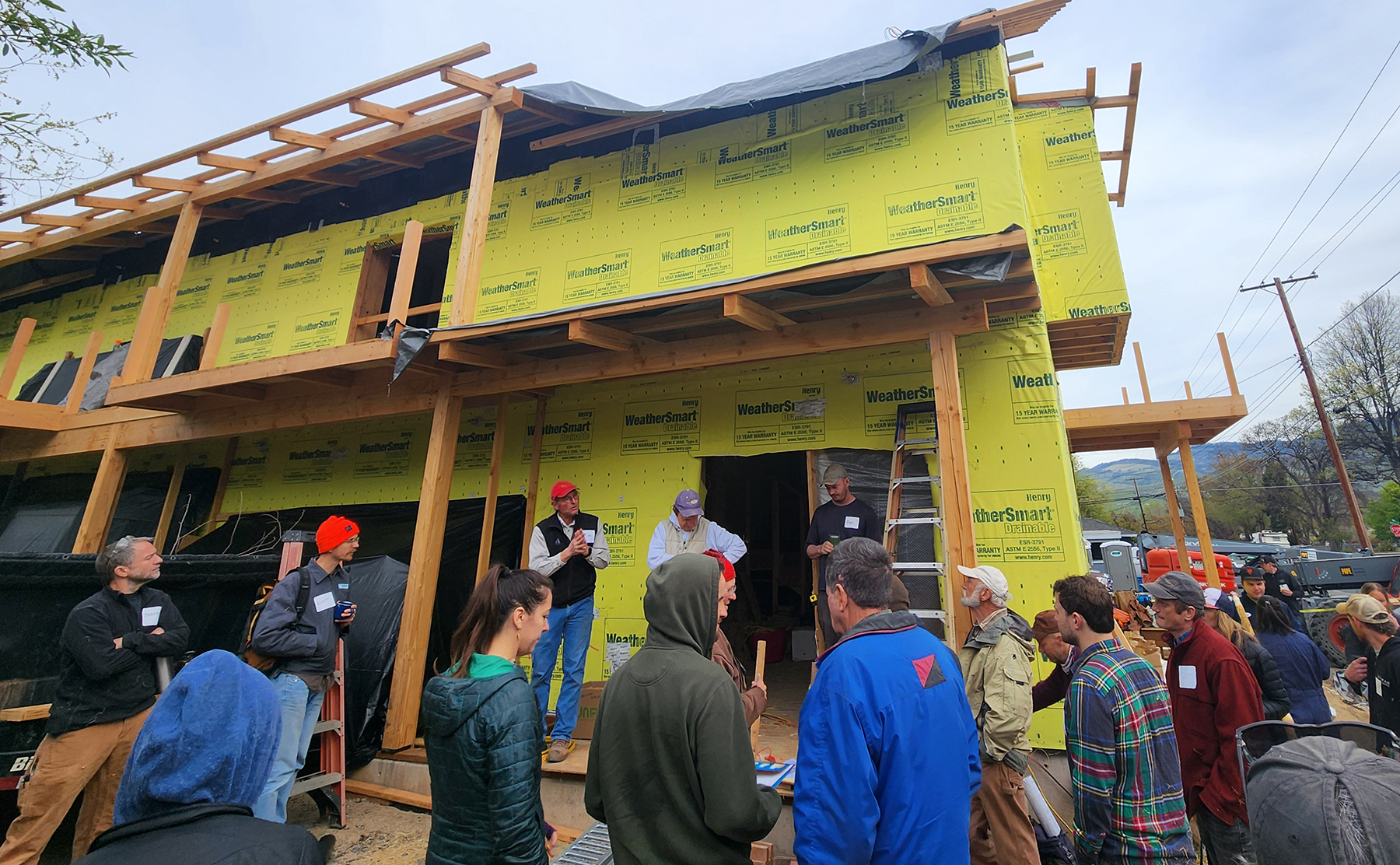 Courtesy of Luke Lombardi
Courtesy of Luke Lombardi In the fable The Three Little Pigs, the first pig builds a house of straw, only to have it blown down by the big bad wolf.
Despite the pervasive idea that straw is less than optimal for building, well, anything, a new housing development in Ashland, Oregon, called Oceanspray Townhomes, is leveraging straw bale construction to make the residences there more eco-friendly and energy efficient.
“The construction industry has a big problem in that most of the materials that are commonly used significantly contribute to the release of greenhouse gases,” said Luke Lombardi, P.E., a senior sustainability consultant with Buro Happold who is an advocate for natural building solutions and who volunteered with construction on the Oceanspray project. “We’d like to get to net-zero carbon, but it’s a challenge to figure out how. Straw bale construction isn’t a new technology, but it’s very approachable and can be used in insulation and building material to help reduce our carbon footprint.”
Further reading:
- Got face masks? Make a road!
- The future of construction? The case for 3D-printed, biobased materials
- How living materials can shape the future built environment
Massey Burke, director of the California Straw Building Association, says the U.S. generates 22 million tons of straw each year. It’s the waste produced during haymaking – and, historically, that waste is burned, adding to local air pollution and greenhouse gas emissions. But, she says, this natural resource can instead be used for building, either as a compressed bale or in new, prefabricated “straw-insulating building matrix” panels being developed.
“What’s so interesting about straw building is that it can be a big part of the circular economy,” she said. “We have this waste that we need to manage. We need building materials that are more environmentally friendly. And if you want to tackle these problems at the same time, straw building can do that.”
Optimizing an age-old technique
More than a century ago, with the advent of the straw baler, farmers in Nebraska started using bales to create strong walls for their houses. Anthony Dente, P.E., a principal at Verdant Structural Engineers and a champion for natural building, says many of these homes are still standing today.
“Full bale construction (a building method that uses compressed blocks of straw as structural elements and insulation) is a bit like stacking up giant, fuzzy masonry blocks. You can then plaster over them, using a reinforced-plaster system, or use stucco or adobe to build,” he explained. “Their use gives you a unique architectural feel, with 18-inch- to 2-foot-thick walls, which some people really love. It’s a great insulator, with a R-54 (insulation) value, which provides wonderful acoustics and thermal efficiency.”
Builders are using straw bales in several different ways.
The old-school Nebraska approach, which is best for smaller structures, leverages straw bales as bricks. They create the load-bearing walls and are reinforced with vertical steel beams so a roof can be placed on top.
Other engineers use a post-and-beam wooden framework to support the roof, with straw bales fitted between those beams. Here, the bales are not weight bearing, but they do form an important insulating layer. Finally, some designers now use straw bales to wrap conventional building structures to help with insulation and fire protection.
 Courtesy of Luke Lombardi
Courtesy of Luke LombardiThe Oceanspray buildings were built using the second method: traditional wood beams, with straw bales as insulation. Lombardi says these homes will achieve an 85% reduction in emissions compared with typically constructed homes.
“There is a tremendous need for housing in the country today, and we could meet that need with a much smaller, healthier handprint if more of it was built like Oceanspray Townhomes,” he said.
The future of straw building
The Oceanspray Townhomes development is the first multistory housing offering known to leverage straw bale construction in the U.S. But Dente says he believes that growing interest in biogenic building materials will help scale up use.
While the construction industry is, on the whole, quite conservative when it comes to new materials, he believes advances like the prefabricated straw insulation panel, which was developed by his company, will help encourage greater interest in straw as a building material.
“We are seeing interest in straw building grow across the country,” Dente said. “From a material acquisition standpoint, it’s a really smart idea – it’s available right now without having to invent any new chemistry or material, and it can comply with building codes.”
When he is discussing the benefits of straw bale building, people often ask whether straw is higher performing than more conventional construction materials. But, Dente says, that’s not the right question.
“If we can get straw to be equally performing to what we have now – meeting the cost and performance of conventional materials but it’s something that’s wildly nontoxic and carbon friendly?” he said. “That would be an incredible achievement. And we are definitely working toward that.”
In the meantime, Lombardi says existing straw building projects can help show engineers, and the greater construction industry, just what is possible with straw materials.
“Straw bales can provide a great building material – and when you start connecting with engineers and designers working with straw bale, you can see just what it can do,” Lombardi said.
To that end, organizations like CASBA and other groups that are working to scale up the use of more eco-friendly building materials are doing their part. But ultimately, Burke believes, more widespread adoption of straw building will come down to the “unglamorous” work of education and advocacy.
“You can find straw in the International Residential Code now, but it has to be adopted by local jurisdictions. We have a code team working on that, as well as other building code efforts,” she said. “It’s going to take time to optimize our techniques, training, and labor force so the industry can see what straw options are out there and how they can use them to solve the problems they are trying to solve.”



